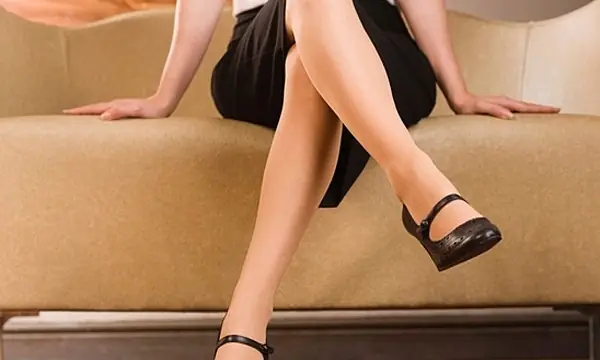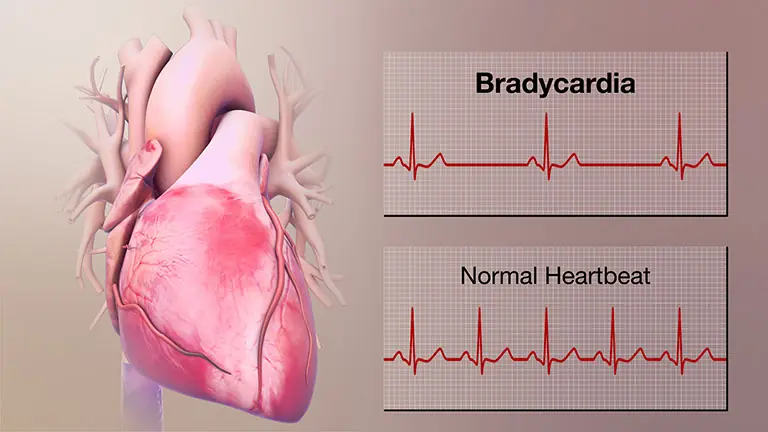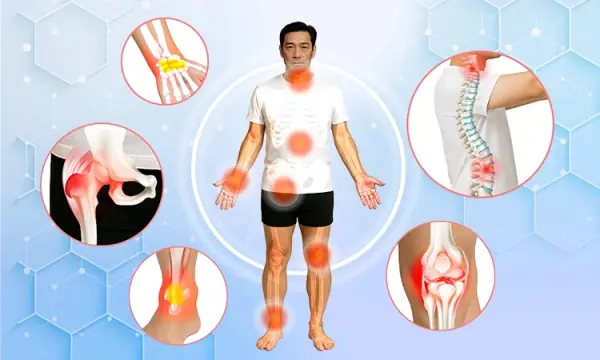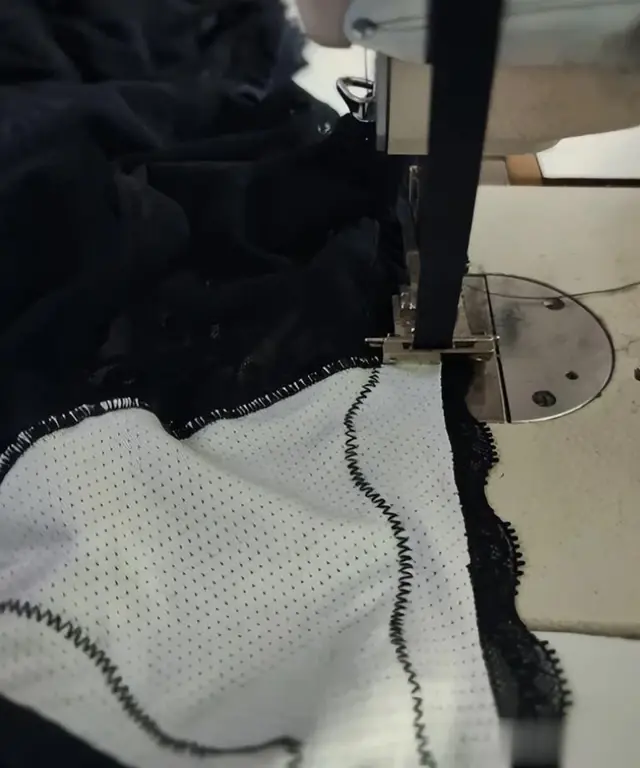
Health 09/06/2025 23:07
Why should women not sit with their legs crossed?
Sitting with one leg crossed over the other is a common occurrence for many people. Scientists have recently discovered that sitting and crossing your legs is the cause of many diseases.

Sitting and crossing your legs is a common occurrence for many people. Scientists have recently discovered that sitting and crossing your legs is the cause of many diseases.
Research shows that the consequences of sitting with your legs crossed for too long include: high blood pressure, varicose veins, and nerve damage.
Sitting with your legs crossed can temporarily increase blood pressure.
Peroneal nerve palsy
Sitting in a certain position for too long can cause numbness in your legs and feet. Sitting with your legs crossed can increase pressure on the peroneal nerve behind the knee, which provides sensation to the lower leg and foot, but the numbness is only temporary. However, keeping the same position for many hours can lead to peroneal nerve palsy, which makes you unable to lift the upper half of your foot and toes. In fact, to avoid numbness in your legs due to sitting with your legs crossed, we should change positions as soon as we feel uncomfortable.
Affects blood pressure
When measuring blood pressure, doctors or nurses often ask you to put your hands on the table and not cross your legs. The reason is because they are concerned that sitting with your legs crossed will affect the test results by increasing blood pressure. In 2010, several studies showed that sitting with your legs crossed can increase blood pressure, while another study found that this made no difference. However, many of these studies were small in size and relied on taking blood pressure results only once.
One of the larger studies was conducted at a hypertension treatment center in Istanbul, Turkey. Researchers there recorded patients' blood pressure when they sat with their legs crossed and when they did not. The results: blood pressure was higher when the patients sat with their legs crossed, but when the blood pressure was measured just three minutes after the person had uncrossed their legs, blood pressure returned to normal. People whose blood pressure increased the most when they sat with their legs crossed tended to be those who had been treated for high blood pressure. The researchers suggest that one explanation is that placing one thigh on top of the other increases the amount of blood pumped from the heart, causing blood pressure to rise. Another explanation is that blood pressure increases because the leg muscles move without the need for joint movement, increasing the resistance to blood flow through the blood vessels. This may also explain why crossing the legs at the ankles does not have the same effect.
In an attempt to assess which explanation is correct, a study in Nijmegen, the Netherlands, took a number of measurements of the body. The researchers found that resistance in the blood vessels did not increase when the heart rate was slow and the legs were crossed, but the amount of blood leaving the heart increased, suggesting that the increased blood pressure was due to the increased blood flow to the heart when the legs were crossed. So sitting cross-legged may temporarily increase blood pressure, but there is no evidence of long-term consequences. With one exception: people at risk of blood clots are advised not to sit with their legs crossed for long periods of time, as the obstruction of blood flow may increase the risk of blood clots forming deep in the veins.

Does sitting cross-legged cause varicose veins?
The cause of varicose veins remains a mystery. Normally, small valves in the blood vessels help prevent blood from flowing in the wrong direction, but if these valves weaken, blood can pool, forming large veins called varicose veins. Varicose veins can be affected by sitting with your legs crossed, as this position increases the resistance of blood to the heart, causing varicose veins.
The Impact of Crossing Your Legs on Your Joints
Research shows that people who cross their legs for more than three hours a day tend to lean forward and round their shoulders. But the study relied on people's own estimates of how long they spent crossing their legs. Studies published this year found that if people were asked to sit upright while crossing their legs, their posture problems would improve. Incidentally, nearly twice as many people crossed their right leg over their left leg as those who crossed their left leg over their right.
A study from the University Medical Centre in Rotterdam, the Netherlands, suggests that crossing your legs may be beneficial. Researchers looked at young men and women while they sat upright, crossed their legs at the thighs or at the ankles. They found that sitting with their legs crossed increased the elongation of the pear-shaped body by 11% compared to sitting uncrossed, and by 21% compared to standing.
So, if you like to sit cross-legged, you probably won't hurt yourself as long as you don't sit for so long that both legs go numb.

Sitting and crossing your legs is a common occurrence for many people. Scientists have recently discovered that sitting and crossing your legs is the cause of many diseases.
Research shows that the consequences of sitting with your legs crossed for too long include: high blood pressure, varicose veins, and nerve damage.
Sitting with your legs crossed can temporarily increase blood pressure.
Peroneal nerve palsy
Sitting in a certain position for too long can cause numbness in your legs and feet. Sitting with your legs crossed can increase pressure on the peroneal nerve behind the knee, which provides sensation to the lower leg and foot, but the numbness is only temporary. However, keeping the same position for many hours can lead to peroneal nerve palsy, which makes you unable to lift the upper half of your foot and toes. In fact, to avoid numbness in your legs due to sitting with your legs crossed, we should change positions as soon as we feel uncomfortable.
Affects blood pressure
When measuring blood pressure, doctors or nurses often ask you to put your hands on the table and not cross your legs. The reason is because they are concerned that sitting with your legs crossed will affect the test results by increasing blood pressure. In 2010, several studies showed that sitting with your legs crossed can increase blood pressure, while another study found that this made no difference. However, many of these studies were small in size and relied on taking blood pressure results only once.
One of the larger studies was conducted at a hypertension treatment center in Istanbul, Turkey. Researchers there recorded patients' blood pressure when they sat with their legs crossed and when they did not. The results: blood pressure was higher when the patients sat with their legs crossed, but when the blood pressure was measured just three minutes after the person had uncrossed their legs, blood pressure returned to normal. People whose blood pressure increased the most when they sat with their legs crossed tended to be those who had been treated for high blood pressure. The researchers suggest that one explanation is that placing one thigh on top of the other increases the amount of blood pumped from the heart, causing blood pressure to rise. Another explanation is that blood pressure increases because the leg muscles move without the need for joint movement, increasing the resistance to blood flow through the blood vessels. This may also explain why crossing the legs at the ankles does not have the same effect.
In an attempt to assess which explanation is correct, a study in Nijmegen, the Netherlands, took a number of measurements of the body. The researchers found that resistance in the blood vessels did not increase when the heart rate was slow and the legs were crossed, but the amount of blood leaving the heart increased, suggesting that the increased blood pressure was due to the increased blood flow to the heart when the legs were crossed. So sitting cross-legged may temporarily increase blood pressure, but there is no evidence of long-term consequences. With one exception: people at risk of blood clots are advised not to sit with their legs crossed for long periods of time, as the obstruction of blood flow may increase the risk of blood clots forming deep in the veins.

Does sitting cross-legged cause varicose veins?
The cause of varicose veins remains a mystery. Normally, small valves in the blood vessels help prevent blood from flowing in the wrong direction, but if these valves weaken, blood can pool, forming large veins called varicose veins. Varicose veins can be affected by sitting with your legs crossed, as this position increases the resistance of blood to the heart, causing varicose veins.
The Impact of Crossing Your Legs on Your Joints
Research shows that people who cross their legs for more than three hours a day tend to lean forward and round their shoulders. But the study relied on people's own estimates of how long they spent crossing their legs. Studies published this year found that if people were asked to sit upright while crossing their legs, their posture problems would improve. Incidentally, nearly twice as many people crossed their right leg over their left leg as those who crossed their left leg over their right.
A study from the University Medical Centre in Rotterdam, the Netherlands, suggests that crossing your legs may be beneficial. Researchers looked at young men and women while they sat upright, crossed their legs at the thighs or at the ankles. They found that sitting with their legs crossed increased the elongation of the pear-shaped body by 11% compared to sitting uncrossed, and by 21% compared to standing.
So, if you like to sit cross-legged, you probably won't hurt yourself as long as you don't sit for so long that both legs go numb.
News in the same category


3 digestive can.cers can be cured if detected early

3 types of vegetables and fruits are "parasite nests" invisible to the naked eye, but many people consider them treasures

Is swollen lymph nodes in the neck caused by cancer?

A Shocking Warning About 5 "Silent Kil.lers" of Blo.od Glucose

The wonderful health benefits of turmeric for human health

What To Eat During Your Period: Foods That Help Reduce Cramps and Foods To Avoid

5 habits to prevent colorectal can:cer

What is the disease of irregular fast and slow heartbeat?

What happens when joints degenerate?

Potential way to cure HIV permanently found

What happens when you eat too much saturated fat?

Japanese Doctor Reveals 3 Everyday Foods That Naturally Boost Immunity and Reduce Frequent Illness

Can.cer May Reveal Itself Through These 2 Nighttime Warning Signs — Everyone Should Be Aware

5 warning signs of oral can:cer

15 Years Can.cer-Free: Japanese Doctor Shares 5 Simple Habits to Keep Can.cer Cells from Returning

Diabetics are ‘very afraid’ of a spice that is abundant in the market: American experts say it is ‘as good as prescription drugs’

Rub Ginger on the Soles of Your Feet Before Bed, and You’ll Experience Its “Miraculous” Health Benefits

What happens to your body if you drink orange juice every day?
News Post

Can:cer can 'emit' these 2 signs at night, everyone should know to be alert
Health 09/06/2025 23:28

Real advice: Don't wear these 5 types of underwear for too long, because it will cause more "health damage"!
Tips 09/06/2025 23:22

9 things to remember to avoid electrical short circuits that can cause d.e.a.dly fires and ex.plos.ions
Tips 09/06/2025 23:19

4 Common Clothes-Drying Mistakes That Seem Harmless But Are Surprisingly Harmful — And Many Families Make Them Every Day
Facts 09/06/2025 23:15

3 digestive can.cers can be cured if detected early
Health 09/06/2025 23:08

3 types of vegetables and fruits are "parasite nests" invisible to the naked eye, but many people consider them treasures
Health 09/06/2025 23:01

Rare genetic mutation allows some people to thrive on 4 hours of sleep, study suggests
Facts 09/06/2025 22:58

3 Types of Fruits and Vegetables Are Hidden 'Parasite Nests' Invisible to the Naked Eye — Yet Many People Treat Them Like Treasures
Facts 09/06/2025 22:29

Is swollen lymph nodes in the neck caused by cancer?
Health 09/06/2025 22:22

Add This Ingredient When Marinating Beef to Keep It Tender and Juicy—No Matter How You Cook It
Tips 09/06/2025 19:45

When Booking a Hotel Room, Choose Floors 3 to 6 – A Golden Tip for Frequent Travelers
Tips 09/06/2025 19:33

A Shocking Warning About 5 "Silent Kil.lers" of Blo.od Glucose
Health 09/06/2025 19:23

Don’t Waste Money on Termite Control Services! Try These 6 Cheap Natural Remedies Already in Your Home
Tips 09/06/2025 19:00

Only the 'Foolish' Would Combine These 5 Things with Pork — It May Taste Good Now, But It Invites Illness Later
Facts 09/06/2025 18:12

Learn How to Plant and Grow Cilantro (Coriander)
Garden 09/06/2025 16:31

Unleash the Versatility of Nettle: 11 Non-Stinging Ways to Harness its Power
Garden 09/06/2025 16:26

How To Regrow Celery From Scraps
Garden 09/06/2025 16:20

The wonderful health benefits of turmeric for human health
Health 09/06/2025 15:06

How To Grow Sweet Potatoes: Ultimate Care & Growing Guide
Garden 09/06/2025 15:01